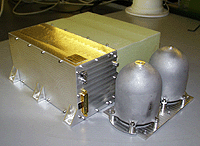
Ptolemy
NSSDC ID: PHILAE -05
Mission Name: Philae
Principal Investigator: Dr. Ian Wright
Description
The Ptolemy instrument is an evolved gas analyzer designed to study the chemical composition of the outer layer of the comet nucleus. The scientific goal is to understand the geochemistry of light elements by determining their nature, distribution, and isotopic composition. The scientific objectives of Ptolemy are to: evaluate the link between water ice on a comet and water on Earth; comprehend the internal balance of volatiles on a comet and describe the cosmochemical fundamentals of cometary formation; elucidate the nature of organic components present on a comet and assess the relationship with equivalent materials known from other Solar System reservoirs; determine the nature of low temperature mineral components present on a comet and decipher the formation history of such materials; document certain features of any high-temperature, refractory, minerals; and assess the relevance of comets to the operation of processes such as planet formation and the origin of life. The instrument concept is termed 'MODULUS' which stands for Methods Of Determining and Understanding Light elements from Unequivocal Stable isotope compositions.
The Ptolemy system consists of a heating and gas management system, an analytical system, and an ion trap mass spectrometer. Samples are collected from the surface or sub-surface by the Sample Drilling and Distribution (SD2) apparatus and placed into one of four ovens mounted on a circular, rotatable carousel. Three of the ovens are designed for solid samples and the fourth contains a gas-trapping substrate to collect volatiles from the near-surface cometary atmosphere. After a sample is deposited into an oven, it is rotated on the carousel to a "tapping station" where it is connected to the inlet of the gas management system. Heating in the oven causes volatiles to be released from the sample into the gas management system and transported to the analytical system where they are quantified, purified, and chemically reacted where necessary to produce a relatively simple gas mixture. The mixture can go through one of three analytical channels containing gas chromatography columns and additional chemical processing reactors or it can go directly to the ion trap mass spectrometer. Gas entering the three analytical channels is also forced by a supply of helium carrier gas to the mass spectrometer.
The ion trap mass spectrometer is designed to assess what gases are present in the sample and to measure stable isotope ratios. Gases are ionized as they flow into the chamber. Un-ionized gases and excess helium flow to an external vent tube. The ionized species become trapped in an electrode structure where they are sequentially ejected according to their mass by a combination of rapidly changing radio frequency potentials applied to the electrodes. The ejected ions are detected by an electron multiplier. The ion beam measurements made by the electron multiplier are integrated over a number of consecutive mass sweeps and recorded. The typical duty cycle is about 10 ms. The mass spectrometer has two operational modes. In qualitative analytical mode it can operate over a large mass range (anywhere between m/z=12 to m/z=150). For isotope ratio determination the mass range is restricted (for example, m/z = 43 to 47 for measurements of 12C/13C in carbon dioxide). The instrument will be calibrated in-situ using a reference gas. Ptolemy is about the size of a small shoebox and has a mass of less than 5 kg.
Funding Agency
- European Space Agency (International)
Discipline
- Planetary Science: Small Bodies
Additional Information
Questions or comments about this experiment can be directed to: Dr. David R. Williams.
Personnel
| Name | Role | Original Affiliation | |
|---|---|---|---|
| Dr. Ian Wright | Principal Investigator | Open University | I.P.Wright@open.ac.uk |
| Dr. R. F. Turner | General Contact | Rutherford Appleton Laboratory |
 Ptolemy Project Page - Open University
Ptolemy Project Page - Open University
